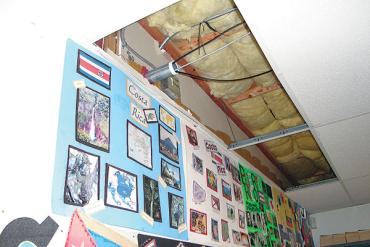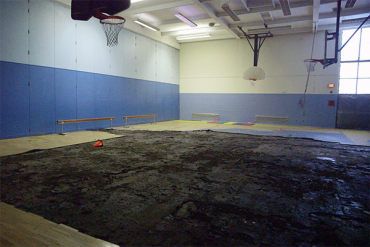More than half of public school buildings in this country are in dire need of repair. As we’ve seen from the strikes by educators across the country, and the wave of pro-public education officials elected in last fall’s midterm elections, teachers, parents and communities want safe and welcoming public schools. These damaged buildings can’t provide the foundation for a good education, because teachers can’t teach and children can’t learn in crumbling schools.
“Every day, millions of students and educators across the country attend schools that put their health and safety at risk—black toxic mold on floors, classrooms without heat, leaking ceilings and contaminated water,” says AFT President Randi Weingarten. “We cannot send our kids to schools in these conditions and expect them to learn and thrive. Our children deserve better.”
The federal government provides no funding for school construction, a vital part of our country’s infrastructure, but a new bill introduced in Congress could change that. On Jan. 30, House Democrats unveiled the Rebuild America’s Schools Act, a plan to invest $100 billion in our nation’s public school system, improving both the physical and digital infrastructure of schools across the country.
“Thanks to the leadership of Chairman Bobby Scott and Sens. Jack Reed and Sherrod Brown, Congress can take long-overdue action to address the deteriorating and obsolete school facilities that exist in far too many of our communities. Rebuilding America’s public schools requires making our school infrastructure a priority and committing resources to back that claim up,” Weingarten says.
Many states aren’t meeting the needs of their pubic education systems, and kids and educators marooned in decrepit classrooms without adequate resources are bearing the cost of that disinvestment. Recent research from the AFT found that, controlling for inflation, 25 states spent less on K-12 education in 2016 than they did before the recession. Schools in these states have been shortchanged by $19 billion.
AFT members are on the front lines of this issue. Our members deal with the results of crumbling infrastructure on a daily basis. They've seen desks covered with lead paint chips and dust, visible mold in classrooms, even unguarded radiators and scalding hot steam pipes.
Not only can decaying school infrastructure result in illness, it also hurts children’s academic performance. Students and staff get sick more often. They miss time from school. Classrooms are sometimes unusable when heating and cooling systems don’t work. Leaks and mold destroy expensive computers, musical instruments, books and other materials.
Our members also know all too well that this problem is most severe in America’s rural and urban low-income communities. Since schools count on local funding for repairs and resources, wealthy communities have better schools. That means that poor kids, especially those of color, bear the heaviest burden. According to the Alliance to Reclaim Our Schools, “Most education spending comes from local and state funds. Schools serving Black and Brown students are systematically sabotaged. Across the country, districts with large majorities of students of color, and low wealth districts on average, spend less per student than districts serving the fewest students of color and wealthier districts.”
Allocating federal funds to rebuild these schools would be an important step toward ensuring that every student, regardless of family wealth, can attend a safe, welcoming and high-quality public school.
School infrastructure extends beyond roofs, walls and floors into the digital realm. Many schools aren’t keeping up with the ever-changing digital landscape. They lack the physical infrastructure to accommodate digital learning. Education SuperHighway, an organization that advocates for digital improvements to public schools, found that 6.5 million students are still waiting to be connected to broadband, and more than 2,000 schools across the country still need high-speed fiber connections. This bill would address that fundamental gap that puts many students at a disadvantage.
Investments in public education enjoy overwhelming support across the nation, as support for teacher uprisings across the country has made abundantly clear. In a recent Pew Research Center survey, the majority of Americans place funding public education among the top items on Congress and the president’s to-do list. The message is clear: Americans want lawmakers to fund our future.
You can join the call to support this bill. Use the hashtag #BuildSchoolsNotWalls to share with friends and followers on Facebook and Twitter what safe, welcoming and well-resourced schools would look like to you.
[Annette Licitra, Elizabeth Sell]



